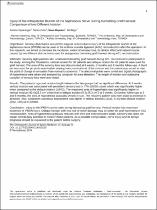| dc.contributor.author | Sipahioğlu, Serkan | |
| dc.contributor.author | Zehir, Sinan | |
| dc.contributor.author | Baykara, İslam | |
| dc.contributor.author | Bilge, Ali | |
| dc.date.accessioned | 2019-05-13T09:07:54Z | |
| dc.date.available | 2019-05-13T09:07:54Z | |
| dc.date.issued | 2014 | |
| dc.identifier.citation | Sipahioğlu, S., Zehir, S., Baykara, İ., Bilge, A. (2014). Injury of the infrapatellar branch of the saphenous nerve during hamstring graft harvest: Comparison of two different incision. Orthopaedic Journal of Sports Medicine, 2(11_suppl3). | en_US |
| dc.identifier.issn | 2325-9671 | |
| dc.identifier.uri | https://doi.org/10.1177/2325967114S00135 | |
| dc.identifier.uri | https://hdl.handle.net/11491/1896 | |
| dc.description.abstract | Objectives: Sensory disturbance around the surgical incision due to injury of the infrapatellar branch of the saphenous nerve (IPBSN) can be seen in the anterior cruciate ligament (ACL) reconstruction after the operation. In this research, we aimed to compare the incidence, extent of sensory loss, its clinical effect and natural course caused by two different skin incisions used for autogenous hamstring graft harvest during ACL reconstruction. Methods: Seventy eight patients who underwent hamstring graft harvest during ACL reconstruction participated in the study. Among the 78 patients, vertical incision for 36 patients and oblique incision for 42 patients were used for graft harvest. The area of the sensory loss was documented at 6 weeks, 3 months and 6 months follow-ups. A blunt pin was used for pin prick examination starting from proximal end of the incision and the patient was asked to note the point of change in sensation from normal to abnormal. The abnormal points were joined and digital photographs of hypesthesia were taken and analysed by computer for area detection. The length of incision and subjective complain of sensory loss were also noted. Results: The patients’ age and incision length between the two groups had no significant difference. At 6 weeks, vertical incision was associated with persistent sensory loss in 77% (28/36) cases which was significantly higher when compared to the oblique incision (19/42). The measured area of hypesthesia was significantly higher in vertical incision (42.4±22.3 cm2) than that in oblique incision (9.3±15.3 cm2) at 6 weeks. On further follow-ups at 3 and 6 months, the area of hypesthesia gradually shrunk in size. The recovery pattern was from distal to proximal in direction. Also, subjective cutaneous anaesthesia was higher in vertical incision (15/36, 41%) than oblique incision (6/42, 14%) at 6 months. Conclusion: Injury to the IPBSN can be seen during hamstring graft harvest. Vertical incision has maximum incidence of IPBSN injury. Oblique incision with less risk of nerve damage may be better for graft harvesting in ACL reconstruction. Area of hypesthesia gradually reduces with time and even recovers totally. Sensory loss does not impair normal daily activities in most of these patients. As a possible complication, nerve injury and its benign prognosis should be explained to the patient before surgery. © The Author(s) 2014. | en_US |
| dc.language.iso | eng | |
| dc.publisher | SAGE Publications Ltd | en_US |
| dc.relation.isversionof | 10.1177/2325967114S00135 | en_US |
| dc.rights | info:eu-repo/semantics/openAccess | en_US |
| dc.rights | Attribution-NonCommercial-NoDerivs 3.0 Unported (CC BY-NC-ND 3.0) | * |
| dc.rights.uri | https://creativecommons.org/licenses/by-nc-nd/3.0/ | * |
| dc.subject | [Belirlenecek] | en_US |
| dc.title | Injury of the infrapatellar branch of the saphenous nerve during hamstring graft harvest: Comparison of two different incision | en_US |
| dc.type | other | en_US |
| dc.relation.journal | Orthopaedic Journal of Sports Medicine | en_US |
| dc.department | Hitit Üniversitesi, Tıp Fakültesi, Cerrahi Tıp Bilimleri Bölümü | en_US |
| dc.identifier.volume | 2 | en_US |
| dc.identifier.issue | 11 | en_US |
| dc.relation.publicationcategory | Diğer | en_US |



















